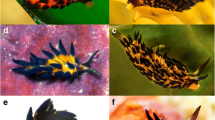Abstract
The Quadrifoliovariinae is revised and three new species of Quadrifoliovarium Yamaguit, 1965 from acanthurid fishes of the genus Naso from waters of the Indo-Pacific are described: Q, maceria n. sp. from N.␣tonganus, N. annulatus, N. fageni and N. brevirostris; Q. simplex n. sp. from N. tonganus and N.␣annulatus; and Q. quattuordecim n. sp. from N. tonganus. Amendments are made to the characterisation of the Quadrifoliovariinae, Quadrifoliovarium, Bilacinia Manter, 1969 and Unilacinia Manter, 1969 in light of observations on type and new material. A molecular phylogeny based on ITS2 and 28S regions of the ribosomal DNA is proposed. The phylogeny suggests that U. asymmetrica is the most basal taxon and Q.␣simplex n. sp. and Q. quattuordecim n. sp. the most derived. Evolution of morphological traits within the Quadrifoliovariinae are discussed in light of the molecular phylogeny. Molecular sequences of the ITS2 rDNA were identical between specimens of Q. pritchardae collected off Exmouth (Indian Ocean), Heron Island and Lizard Island (Western Pacific) and Moorea (far Eastern Indo-Pacific), indicating a broad Indo-Pacific distribution. All members of the subfamily are recorded only from the acanthurid genus Naso, with the exception of B. lobatum (Yamaguti, 1970), which has been recorded from a pomacanthid. The restricted host range of the group is discussed in the light of the phylogeny of the host genus Naso.
Similar content being viewed by others
References
Adlard R.D., Barker S.C., Blair D., Cribb T.H. (1993) Comparison of the second internal transcribed spacer (ribosomal DNA) from populations and species of Fasciolidae (Digenea). International Journal for Parasitology 23:423–425
Allen G., Steene R., Allen M. (1998) A guide to angelfishes and butterflyfishes Tropical Reef Research. Odyssey Publishing, Singapore, pp. 256
Blair D., Bray R.A., Barker S.C. (1998) Molecules and morphology in phylogenetic studies of the Hemiuroidea (Digenea: Trematoda: Platyhelminthes). Molecular Phylogenetics and Evolution 9:15–25
Bray R.A., Cribb T.H. (2000) The status of the genera Hysterolecithoides Yamaguti, 1934, Neotheletrum Gibson & Bray, 1979 and Machidatrema León-Règagon, 1998 (Digenea: Hemiuroidea), including a description of M. leonae n. sp. from Australian waters. Systematic Parasitology 46: 1–22
Després L., Kruger F.J., Imbert-Establet D., Adamson M.L. (1995) ITS2 ribosomal RNA indicates Schistosoma hippopotami is a distinct species. International Journal for Parasitology 25: 1509–1514
Gibson D.I., Bray R.A. (1979) The Hemiuroidea: terminology, systematics and evolution. Bulletin of the British Museum (Natural History), Zoology 36: 35–146
Gibson D.I. (2002) Family Lecithasteridae Odhner, 1905. In: Gibson D.I., Jones A., Bray R.A. (eds) Keys to the Trematoda. Volume 1. CABI Publishing, Wallingford, pp. 381–396
Johnson J.W. (2002) Naso mcdadei, a new species of unicornfish (Perciforms: Acanthuridae), with a review of the Naso tuberosus species complex. Australian Journal of Zoology 50: 293–311
Klanten S.O., van Herwerden L., Choat J.H., Blair D. (2004) Patterns of lineage diversification in the genus Naso (Acanthuridae). Molecular Phylogenetics and Evolution 32: 221–235
Littlewood D.T.J., Curini-Galletti M., Herniou E.A. (2000) The interrelationships of Proseriata (Platyhelminthes: Seriata) tested with molecules and morphology. Molecular Phylogenetics and Evolution 16: 449–466
Lo C.M., Morgan J.A.T., Galzin R., Cribb T.H. (2001) Identical digeneans in coral reef fishes from French Polynesia and the Great Barrier Reef (Australia) demonstrated by morphology and molecules. International Journal for Parasitology 31:1573–1578
Luton K., Walker D., Blair D. (1992) Comparisons of ribosomal internal transcribed spacers from two congeneric species of flukes (Platyhelminthes: Trematoda: Digenea). Molecular and Biochemical Parasitology 56: 323–328
Machida M., Uchida A. (1990) Trematodes from unicornfishes of Japanese and adjacent waters. Memoirs of the National Science Museum, Tokyo 23: 69–81
Manter H.W., Pritchard M.H. (1961) Studies on digenetic trematodes of Hawaiian fishes: Families Monorchiidae and Haploporidae. Journal of Parasitology 47: 483–492
Manter H.W. (1969) Three new genera of hemiurid trematodes from Australian fishes. Journal Fisheries Research Board of Canada 26: 787–792
Morand S., Müller-Graf C.D.M. (2000) Muscles or testes? Comparative evidence for sexual competition among dioecious blood parasites (Schistosomatidae) of vertebrates. Parasitology 120: 45–56
Pritchard M.H. (1960) Preptetos caballeroi n. gen., n. sp. and Labrifer tertius n. sp. (Trematoda: Lepocreadiidae) from fishes of Hawaii. Libro Homenaje al Dr. Eduardo Caballero y Caballero, Jubileo 1930–1960. Secretaría de Educación Publica, Mexico City, pp. 245–251
Pritchard M.H. (1963) Studies on digenetic trematodes of Hawaiian fishes, primarily families Lepocreadiidae and Zoogonidae. Journal of Parasitology 49: 578–587
Rambaut A. (1996) Se-Al, Sequence Alignment Editor. Version 1.0 alpha 1. Department of Zoology, University of Oxford, Oxford
Rigby M.C., Lo C.M., Cribb T.H., Euzet L., Faliex E., Galzin R., Holmes J.C., Morand S. (1999) Checklist of the parasites of coral reef fishes from French Polynesia, with considerations on their potential role in these fish communities. Cybium 23: 273–284
Swofford D.L. (1998) PAUP*: Phylogenetic analysis using parsimony (and other methods). Version 4.0b. Sinauer Associates, Sunderland, Massachusetts
Yamaguti S. (1965) New digenetic trematodes from Hawaiian fishes, I. Pacific Science 19: 458–481
Yamaguti S. (1970) Digenetic trematodes of Hawaiian fishes. Keigaku Publishing, Tokyo, pp. 436
Acknowledgements
We would like to acknowledge The University of Queensland for facilities and support for the duration of this research. We also acknowledge the staff and management of the research stations of Lizard Island and Heron Island, Australia and Moorea, French Polynesia, for provision of facilities and equipment to make this research possible. Special thanks go to those who aided in collection of material. The principle author was supported by an Australian Postgraduate Award.
Author information
Authors and Affiliations
Corresponding author
Rights and permissions
About this article
Cite this article
Chambers, C.B., Cribb, T.H. Phylogeny, evolution and biogeography of the Quadrifoliovariinae Yamaguti, 1965 (Digenea: Lecithasteridae). Syst Parasitol 63, 59–80 (2006). https://doi.org/10.1007/s11230-005-9007-5
Received:
Accepted:
Published:
Issue Date:
DOI: https://doi.org/10.1007/s11230-005-9007-5




